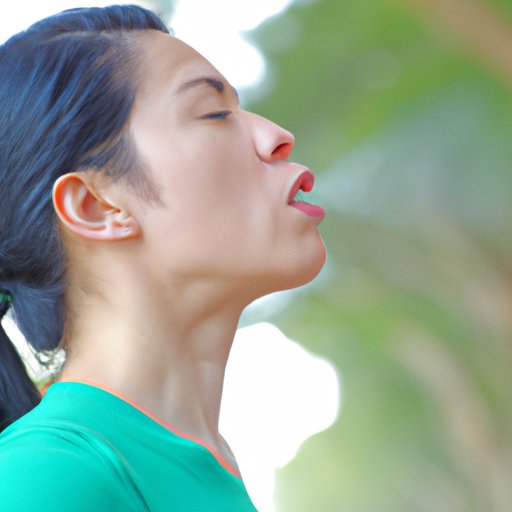Introduction
Breathing is an essential part of our everyday lives. We do it without even thinking about it – but when we exercise, our breath changes in ways that can have a significant impact on our performance and overall health. In this article, we’ll explore how breathing changes during exercise and the physiological effects of exercise on breath.

Examining the Physiological Effects of Exercise on Breath
When we exercise, our body needs more oxygen to produce energy for our muscles. To meet this demand, our breathing rate increases to provide our body with the oxygen it needs. This is known as “respiration” – the process by which oxygen is exchanged between the air and our blood. As our body uses up the oxygen in our blood, carbon dioxide is produced and then exhaled.
The role of oxygen in exercise and breathing is especially important because it is the fuel that powers our muscles. Without adequate oxygen, our muscles will not be able to perform at their highest level. Therefore, it is important to ensure that we are getting enough oxygen through our breath while exercising.
Exploring How Exertion Affects Breath Quality and Quantity
The intensity of the exercise you are doing will affect your breathing rate and the quality of your breath. Generally speaking, the harder you work out, the faster your breathing rate and the deeper your breaths will become. When you are engaged in strenuous activity, your breathing rate can increase up to three times its resting rate.
In addition to increasing your breathing rate, the type of exercise you are doing will also affect your breathing pattern. For example, cardio exercises such as running or cycling tend to involve steady and rhythmic breathing, whereas strength exercises such as weightlifting or bodyweight exercises often require short and powerful breaths.

Investigating the Relationship Between Physical Activity and Breath
The intensity of the exercise you are doing will also affect your breath. Low-intensity activities such as walking and light jogging typically involve shallow and relaxed breathing, while high-intensity activities such as sprinting and interval training involve deep and rapid breathing.
High-intensity interval training (HIIT) is a popular form of exercise that involves alternating periods of intense activity with periods of rest or low-intensity activity. During HIIT, your breathing rate will increase significantly, and you may find yourself gasping for air. This is normal and is a sign that your body is working hard to supply your muscles with the necessary oxygen.
Conclusion
In conclusion, our breathing rate and pattern change depending on the type and intensity of exercise we are doing. Low-intensity activities tend to involve shallow and relaxed breathing, while high-intensity activities involve deep and rapid breathing. Training and practice can help us to develop better breath control and improve our performance during exercise. Further research into the relationship between physical activity and breath is needed to gain a better understanding of how these factors interact.


